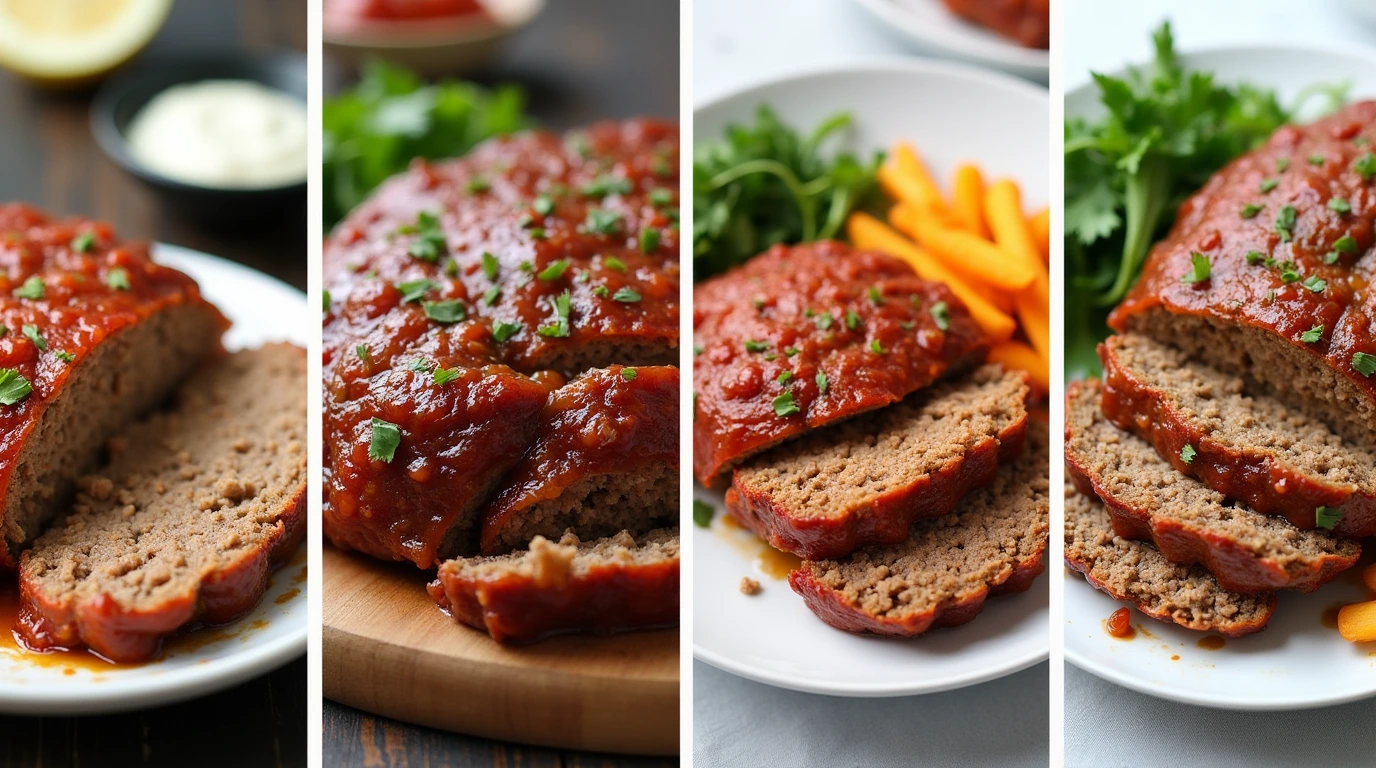Meatloaf is the ultimate comfort food—a classic dish that has graced dinner tables for generations. Its hearty, flavorful profile makes it a go-to for family meals, while its versatility ensures there’s a version to suit every taste. The best part? You don’t need to be a culinary expert to create a meatloaf that’s tender, juicy, and absolutely delicious.
This easy meatloaf recipe simplifies the process without sacrificing flavor, making it perfect for busy weeknights or when you want a fuss-free, crowd-pleasing dish. With simple ingredients you likely already have on hand and a few tips for perfecting the technique, this recipe is guaranteed to become a staple in your meal rotation.
Table of Contents
Get ready to impress your family and friends with a homemade meatloaf that’s not only easy to make but also packed with flavor. Let’s dive into the ingredients and steps to create this classic dish everyone will love!
Ingredients for the Perfect Easy Meatloaf Recipe
Essential Ingredients
- Ground beef
- Breadcrumbs
- Eggs
- Onions and garlic
- Seasonings
To create a flavorful and moist meatloaf, choosing the right ingredients is crucial. Each component plays a specific role in bringing the dish together, balancing texture, taste, and consistency. Here’s a breakdown of the essential ingredients you’ll need for this easy meatloaf recipe:
Ground Beef
The foundation of any great meatloaf is high-quality ground beef. For the best results, choose ground beef with a fat content of 80% lean and 20% fat. This balance ensures your meatloaf stays moist and flavorful without becoming overly greasy. You can also experiment with a mix of ground beef, pork, or even turkey for a slightly different flavor profile.
Breadcrumbs
Breadcrumbs act as a binder, holding the meatloaf together and giving it structure. They also help absorb moisture, keeping the meatloaf from becoming dry. You can use plain breadcrumbs, panko for a lighter texture, or even crushed crackers as a substitute. For a gluten-free option, opt for gluten-free breadcrumbs or crushed oats.
Eggs
Eggs are another essential binding ingredient. They help hold the meatloaf mixture together during baking and contribute to its moist and tender texture. Typically, two large eggs are enough for a standard-sized meatloaf.
Onions and Garlic
Aromatic vegetables like onions and garlic are key to adding depth of flavor to your meatloaf. Finely dice the onions to ensure they blend evenly into the mixture, and mince or grate the garlic for a subtle yet robust flavor. If you prefer a sweeter taste, sauté the onions beforehand to bring out their natural sweetness.
Seasonings
A simple combination of salt, pepper, and Worcestershire sauce elevates the overall flavor of the meatloaf. Worcestershire sauce, in particular, adds a savory umami kick that pairs perfectly with the richness of the ground beef. You can also add dried herbs like parsley, thyme, or Italian seasoning for an herby twist.
These essential ingredients lay the groundwork for a classic, foolproof meatloaf. Each one works in harmony to ensure your dish turns out perfectly seasoned, tender, and full of flavor. With these basics covered, you’re ready to move on to the optional add-ins that can take your meatloaf to the next level!
Sauce Ingredients for Extra Flavor
The sauce is the finishing touch that takes a good meatloaf and makes it unforgettable. A flavorful glaze not only adds a burst of tangy-sweet richness but also locks in moisture during baking. Here’s a closer look at the essential ingredients for creating the perfect sauce for your easy meatloaf recipe:
Ketchup
Ketchup serves as the base of the meatloaf glaze, providing a classic tangy-sweet flavor that complements the savory meat. Its thick consistency helps the sauce cling to the top of the meatloaf, creating that signature shiny glaze. You can use regular ketchup or opt for a low-sugar version if you want to reduce the sweetness.
Brown Sugar
Brown sugar adds a hint of caramelized sweetness to the glaze, balancing the tanginess of the ketchup. When baked, it melts into the sauce, creating a sticky and slightly caramelized topping. Light brown sugar works perfectly, but if you prefer a deeper molasses flavor, you can use dark brown sugar instead.
Mustard
Mustard adds a zesty tang and a touch of heat to the glaze, rounding out the flavors. Yellow mustard is a classic choice for its mild flavor, but you can experiment with Dijon mustard or spicy brown mustard for a more robust kick.
Optional Additions for Customization
While the classic trio of ketchup, brown sugar, and mustard makes a perfect glaze, you can customize it to suit your taste:
- Worcestershire Sauce: Adds a savory, umami depth to the glaze.
- Hot Sauce or Cayenne Pepper: For those who enjoy a bit of heat.
- Balsamic Vinegar: Adds a rich, tangy complexity to the sauce.
- Honey or Maple Syrup: A natural sweetener that adds a subtle, unique flavor.
How to Apply the Sauce
For the best results, apply half of the sauce to the top of the meatloaf before it goes into the oven. This allows the flavors to bake into the meatloaf and create a slightly caramelized crust. Reserve the remaining sauce and brush it on during the last 10-15 minutes of baking for a fresh, glossy finish.
The sauce isn’t just an afterthought—it’s an essential part of the dish that enhances every bite. Whether you stick to the classic recipe or experiment with add-ins, a well-made glaze can transform your meatloaf into a memorable meal.
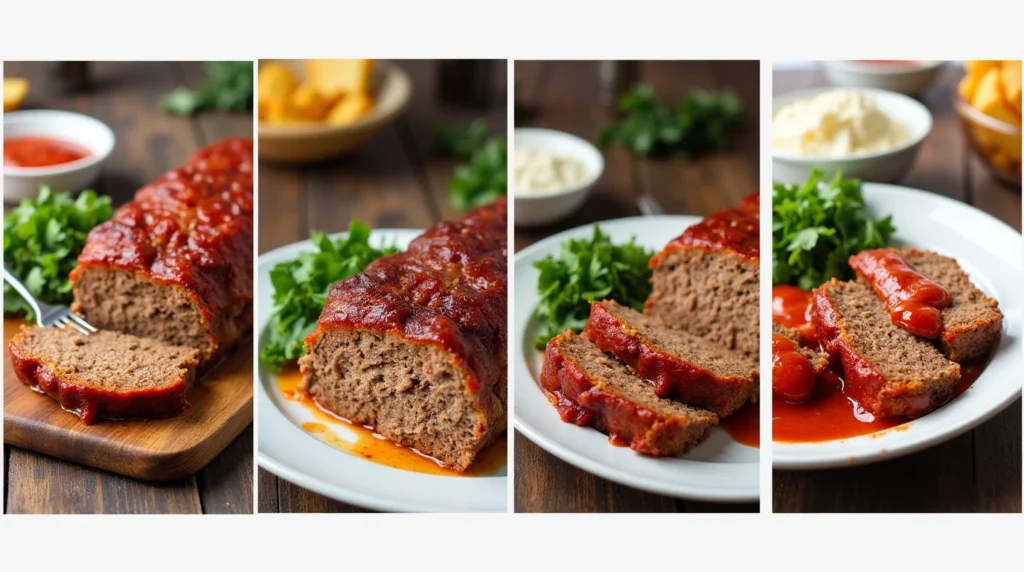
Optional Add-Ins and Variations
One of the best things about meatloaf is its versatility. While the essential ingredients form the foundation, optional add-ins and variations allow you to customize the recipe to suit your taste preferences, dietary needs, or to simply experiment with new flavors. Here’s how you can elevate your meatloaf with creative twists:
Add-Ins for Enhanced Flavor and Texture
- Cheese
- Add shredded cheese like cheddar, mozzarella, or Monterey Jack to the meat mixture for a creamy, rich texture.
- For a surprise twist, stuff the center of the meatloaf with cheese for a gooey core.
- Vegetables
- Finely chopped or grated vegetables like carrots, zucchini, or bell peppers not only add flavor but also boost the nutritional value.
- Mushrooms, when finely chopped, add an earthy depth of flavor and help keep the meatloaf moist.
- Fresh Herbs
- Fresh parsley, cilantro, or basil can brighten the flavors and add a touch of freshness.
- Experiment with dill or chives for a subtle oniony or tangy kick.
- Spices and Seasonings
- Add a pinch of paprika, cayenne pepper, or smoked chili powder for a smoky or spicy kick.
- Italian seasoning, garlic powder, or even curry powder can bring unique flavor profiles to your meatloaf.
Variations for Dietary Preferences
- Turkey or Chicken Meatloaf
- Substitute ground beef with ground turkey or chicken for a leaner option.
- Add a splash of broth or extra vegetables to prevent lean meats from drying out.
- Vegan or Vegetarian Meatloaf
- Replace meat with lentils, black beans, or a mix of mushrooms and nuts for a plant-based version.
- Use flaxseed meal or chia seeds mixed with water as a binder instead of eggs.
- Gluten-Free Meatloaf
- Swap breadcrumbs with gluten-free alternatives like crushed rice crackers, almond flour, or gluten-free oats.
Cultural Twists and Flavor Profiles
- BBQ Meatloaf
- Replace the ketchup glaze with your favorite barbecue sauce for a smoky, tangy flavor.
- Add smoked paprika or liquid smoke to the meat mixture for an extra BBQ kick.
- Italian-Style Meatloaf
- Incorporate Italian sausage into the meat mix and season with oregano, basil, and garlic.
- Use marinara sauce as a glaze and top with shredded Parmesan or mozzarella.
- Asian-Inspired Meatloaf
- Add soy sauce, ginger, and sesame oil to the meat mixture.
- Glaze with a mixture of hoisin sauce and sriracha for a sweet and spicy finish.
- Tex-Mex Meatloaf
- Mix in diced green chilies, corn, and taco seasoning for a Tex-Mex flair.
- Serve with salsa, sour cream, or guacamole on the side.
Experiment with Shapes and Serving Ideas
- Instead of a traditional loaf, shape the mixture into mini meatloaves or meatloaf muffins for faster cooking and easy portioning.
- Try shaping the meatloaf into patties for meatloaf burgers—a fun twist on a classic dish.
By incorporating add-ins and trying out variations, you can transform a basic meatloaf into something truly unique and tailored to your preferences. These options not only add excitement to your meals but also make meatloaf a dish you’ll never tire of.
Step-by-Step Guide to Making Meatloaf Everyone Will Love
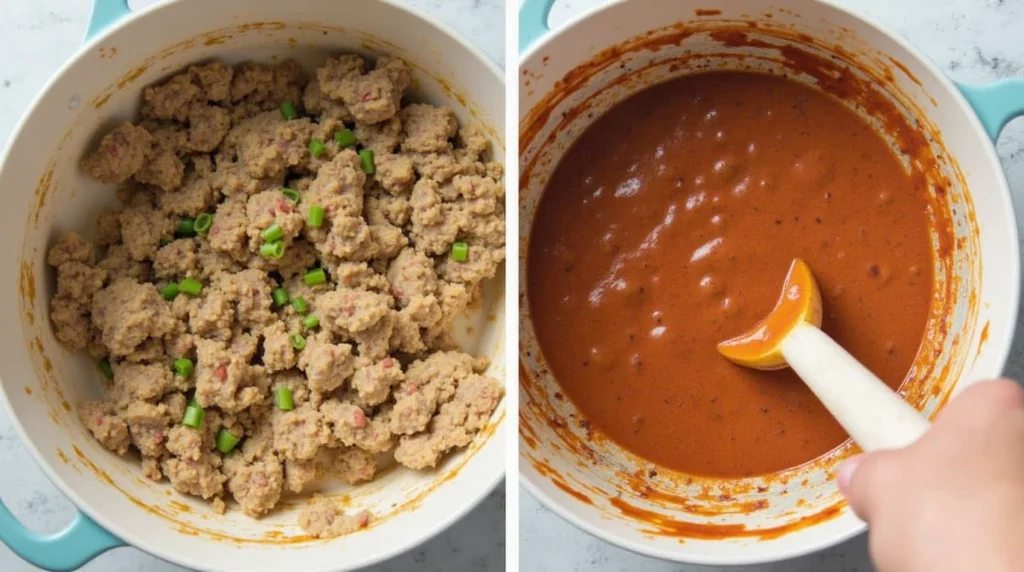
Preparing the Meatloaf Mixture
The key to a moist, flavorful, and perfectly textured meatloaf lies in how you prepare the meat mixture. This process ensures that the ingredients are evenly distributed, the flavors are well-balanced, and the meatloaf holds its shape while staying tender. Here’s a detailed guide to help you master this essential step:
1. Choosing and Preparing the Ground Meat
- Selection of Meat: Start with high-quality ground beef, ideally 80% lean and 20% fat. This fat ratio ensures that your meatloaf is juicy without being greasy. You can also use a combination of meats like ground pork, veal, or turkey for added flavor and variety.
- Temperature Matters: Keep the ground meat cold until you’re ready to mix. This helps maintain the texture and prevents the fat from melting prematurely.
2. Mixing the Dry Ingredients
- Breadcrumbs: Add breadcrumbs to the mixing bowl first. These act as a binder and absorb moisture, ensuring your meatloaf holds together without becoming dense.
- Seasonings: Mix in your dry seasonings, such as salt, pepper, garlic powder, onion powder, and any dried herbs like parsley or thyme. Pre-mixing these with the breadcrumbs ensures even seasoning throughout the meatloaf.
3. Combining the Wet Ingredients
- Eggs: Crack the eggs into a separate small bowl and whisk them lightly before adding them to the mixture. Eggs serve as a binding agent that helps hold everything together.
- Liquid Additions: For extra moisture, include a splash of milk, broth, or Worcestershire sauce. These liquids also enhance the flavor and prevent the meatloaf from drying out during cooking.
4. Incorporating Aromatics and Flavor Boosters
- Onions and Garlic: Finely dice the onions and mince the garlic to ensure they integrate smoothly into the mixture. If you prefer a sweeter, less pungent flavor, sauté the onions and garlic in a little oil before adding them.
- Optional Add-Ins: If you’re including grated vegetables (like carrots or zucchini) or shredded cheese, fold these in at this stage to ensure they’re evenly distributed.
5. Mixing the Ingredients Together
- Gentle Mixing is Key: Add the ground meat to the bowl with the prepared ingredients. Use clean hands to gently combine everything. Overmixing can result in a dense, tough meatloaf, so stop as soon as the ingredients are evenly incorporated.
- Folding Technique: Instead of kneading or pressing, use a folding motion to combine the ingredients. This helps maintain the meat’s light texture.
6. Testing for Flavor (Optional but Recommended)
- Cook a Test Portion: If you’re unsure about the seasoning, take a small portion of the mixture and cook it in a skillet. Taste and adjust the seasoning in the raw mixture as needed before shaping the meatloaf.
7. Shaping the Meatloaf
- Uniform Shape: Transfer the mixture to a loaf pan or shape it by hand on a lined baking sheet. Ensure the loaf is uniform in size to promote even cooking. Avoid pressing it too tightly, as this can make the meatloaf dense.
- Indent the Top: Make a shallow indentation along the top of the loaf. This prevents the meatloaf from puffing up unevenly and helps hold the glaze in place.
Preparing the meatloaf mixture is a simple yet critical step in achieving the perfect balance of flavor, texture, and moisture. With these tips, your meatloaf will come together beautifully every time!
Shaping and Baking Your Meatloaf
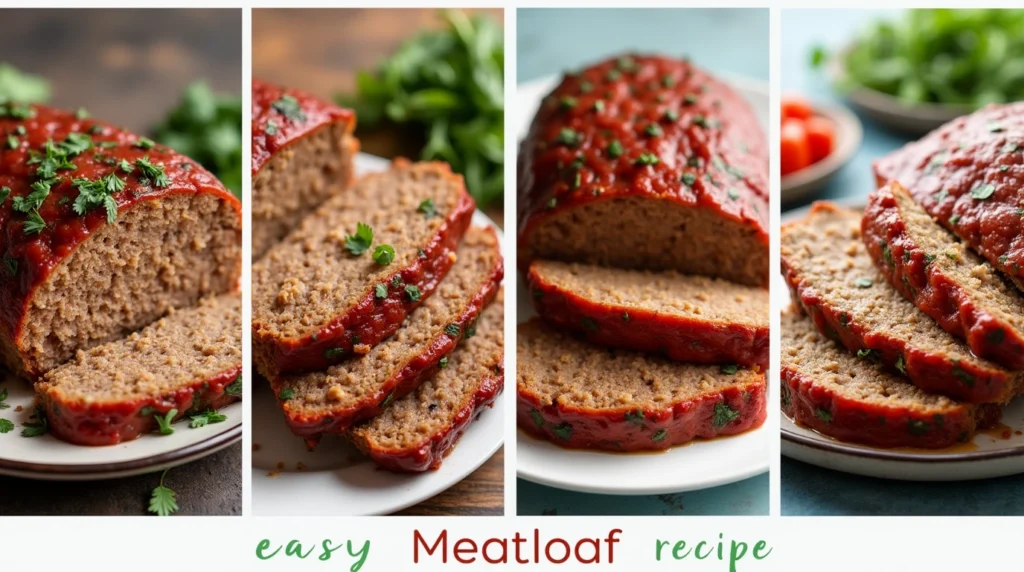
Shaping and baking your meatloaf are essential steps that can directly influence its texture, moisture, and overall presentation. Getting both right ensures that your meatloaf is evenly cooked, holds its shape, and has a delicious, caramelized glaze. Here’s a detailed guide on how to shape and bake your meatloaf to perfection:
1. Shaping the Meatloaf
- Loaf Pan vs. Freeform Shape:
- Loaf Pan: Using a loaf pan is a classic approach. It helps the meatloaf maintain a consistent shape and makes it easier to slice. If you’re using a pan, lightly grease it or line it with parchment paper to prevent sticking. This method works well if you want a more uniform, compact meatloaf.
- Freeform Shape: For a slightly more rustic look, you can shape the meatloaf by hand. Place the mixture on a baking sheet lined with parchment paper or a silicone mat. Shape it into a rectangular or oval loaf, ensuring it’s uniform in thickness so that it cooks evenly. This method allows for a crispier exterior since more of the surface is exposed to direct heat.
- Avoid Packing Too Tightly: When shaping the meatloaf, don’t press the mixture too firmly into the pan or mold it too tightly. Overpacking can cause the meatloaf to become dense and tough. Instead, gently mold the mixture into shape, just enough to hold together.
- Indentation Along the Top: For better heat distribution and even cooking, make a shallow indentation along the top of the meatloaf. This technique helps prevent the meatloaf from puffing up in the middle and allows the glaze to sit neatly on top.
2. Preparing the Oven and Baking Sheet
- Preheat the Oven: Set your oven to 350°F (175°C), the ideal temperature for cooking meatloaf. This temperature allows for even cooking, helping to keep the meatloaf moist inside while ensuring the outside has a nice golden brown color.
- Use a Baking Sheet: If you’re not using a loaf pan, place the shaped meatloaf on a baking sheet lined with parchment paper or a silicone baking mat. The baking sheet helps air circulate around the meatloaf, contributing to an evenly cooked and slightly crisp exterior.
3. Baking the Meatloaf
- Cooking Time: Bake the meatloaf for about 1 hour, but the exact time can vary based on the size and thickness of the loaf. It’s important to check the internal temperature to ensure it’s fully cooked. Insert a meat thermometer into the center of the loaf; it should read 160°F (71°C) for beef or 165°F (74°C) for poultry-based meatloaf.
- Avoid Overbaking: Overbaking can lead to a dry meatloaf, so check the internal temperature about 5 minutes before the recommended cooking time.
- Baking Time Adjustments: If your meatloaf is smaller or in individual portions (e.g., mini meatloafs or meatloaf muffins), reduce the cooking time to about 30-40 minutes. For larger or thicker loaves, you may need to extend the time by 10–15 minutes.
4. Applying the Sauce
- First Coat of Sauce: About 10 minutes before the meatloaf is done, take it out of the oven and brush on a generous layer of the meatloaf glaze. This allows the sauce to set into a sticky, flavorful glaze.
- Final Glaze and Caramelization: After applying the glaze, return the meatloaf to the oven and bake for an additional 10-15 minutes. The sauce will caramelize, creating a glossy, slightly sweet finish. If you like your glaze a little more caramelized, you can turn on the broiler for the last few minutes. Just watch closely to avoid burning.
5. Resting the Meatloaf
- Resting is Crucial: Once your meatloaf is fully cooked and has a beautiful glaze, remove it from the oven and allow it to rest for about 10 minutes. This resting period lets the juices redistribute throughout the meatloaf, keeping it moist and preventing the juices from spilling out when you slice.
- Serving: After resting, use a sharp knife to slice the meatloaf. Be sure to cut into even slices for a uniform presentation and to ensure each piece holds its shape.
6. Additional Tips for Perfect Baking
- Use of Foil: If you’re concerned about the meatloaf drying out, you can tent the loaf with aluminum foil during the first half of the baking process, then remove it to allow the glaze to develop a nice caramelized crust.
- Layering of Flavors: For even more flavor, you can add a second layer of glaze during the last few minutes of baking for a richer, more pronounced flavor profile.
Shaping and baking your meatloaf correctly is just as important as preparing the mixture. By following these steps, you’ll ensure that your meatloaf is not only flavorful and tender but also has a beautifully caramelized top that’s sure to impress.
Adding and Perfecting the Sauce
The sauce is the star of the show when it comes to making meatloaf. Not only does it provide a flavorful and glossy finish, but it also helps seal in moisture, ensuring your meatloaf stays juicy and tender. Perfecting your meatloaf sauce is essential for achieving that perfect balance of sweet, tangy, and savory flavors. Here’s a detailed guide on how to add and perfect the sauce:
1. When to Add the Sauce
- First Layer: The ideal time to apply your sauce is about 10 minutes before your meatloaf is finished baking. At this stage, the meatloaf has cooked enough to set its shape, and the glaze will bake into the surface, creating a delicious, sticky layer.
- Second Coat (Optional): For a more pronounced glaze, you can apply a second layer of sauce in the final 10 minutes of baking. This ensures the sauce becomes deeply caramelized and intensifies the flavor. You’ll want to watch it closely to prevent burning, as the sugar in the glaze can caramelize quickly.
2. Glaze Consistency and Texture
- Thickness of the Sauce: The consistency of your sauce plays a major role in how it behaves during cooking. You want it to be thick enough to stay on top of the meatloaf without running off. If your sauce is too thin, it may not form a good glaze. To thicken the sauce, you can simmer it for a few minutes on the stovetop until it reaches your desired consistency.
- Smooth vs. Chunky: Some people prefer a smooth sauce, while others enjoy a bit of texture. If you like a chunkier sauce, you can add finely chopped onions, tomatoes, or even bell peppers to the ketchup-based glaze. This provides an additional layer of flavor and a bit of contrast in texture.
3. Perfecting the Balance of Flavors
- Sweetness: The sweetness of the sauce typically comes from ingredients like brown sugar, honey, or maple syrup. Adjust the sweetness to your liking by adding more or less sugar. For a more balanced flavor, use a combination of sweeteners, like brown sugar and a splash of honey.
- Tanginess: Ketchup is the primary source of tanginess in many meatloaf sauces. However, you can enhance this with a little mustard or vinegar, such as balsamic or apple cider vinegar. The tangy elements cut through the richness of the meat and provide balance to the overall flavor.
- Umami and Depth: To boost the savory depth of the sauce, add a teaspoon of Worcestershire sauce or soy sauce. These ingredients are rich in umami, which complements the savory flavors of the meat and elevates the overall taste. You could also add a dash of liquid smoke for a subtle smoky flavor.
- Spices: Customize the sauce to your personal taste by adding spices. Paprika, garlic powder, or chili powder can bring warmth and complexity. A pinch of cayenne pepper or hot sauce can also add heat for those who enjoy a little spice.
- Acidity: If you prefer a more tart glaze, a splash of lemon juice or a few teaspoons of mustard can brighten the flavor and add depth. Experiment with the acidity to balance out the sweetness, especially if you’re using a very sweet sauce base.
4. Applying the Sauce
- Generous Coating: When applying the sauce, use a pastry brush or the back of a spoon to spread a generous layer over the top of the meatloaf. Be sure to cover the surface evenly for a nice, uniform glaze.
- Drip-Free Application: For a clean look, apply the sauce carefully, avoiding drips down the sides of the meatloaf. You want the sauce to stay on the top, forming a perfect layer, rather than running off the sides, which could create a mess in your oven.
- Multiple Layers for a Glossy Finish: If you’re adding a second layer of sauce, wait until the first one has baked into the meatloaf for about 15 minutes before applying more. This will create a glossy, thick finish, and the glaze will have time to caramelize without burning.
5. Broiling for a Perfect Finish
- Broiling for Extra Caramelization: For a beautifully caramelized glaze, you can broil the meatloaf for a few minutes at the end of baking. Turn the broiler on high, but be sure to keep a close eye on it, as the glaze can burn quickly. Broiling enhances the sweetness and gives the sauce a beautiful sheen.
- Watch Closely: Place the meatloaf under the broiler for 2-4 minutes, or until the glaze is golden and bubbly. If you want an extra crispy top, broiling at the end is a great way to achieve that texture.
6. Resting After Applying the Sauce
- Let the Glaze Set: Once your meatloaf is done, let it rest for about 10 minutes. This allows the glaze to set, making it easier to slice the meatloaf without disturbing the top layer. The resting period also helps redistribute the juices inside the meatloaf, ensuring each slice remains moist.
By carefully adding and perfecting the sauce, you’re elevating your meatloaf from a simple dish to something special. The sauce not only enhances the flavor but also helps create a beautiful presentation, making every bite an irresistible experience. Whether you stick to the classic glaze or try a unique twist, the sauce is what makes the meatloaf truly memorable.
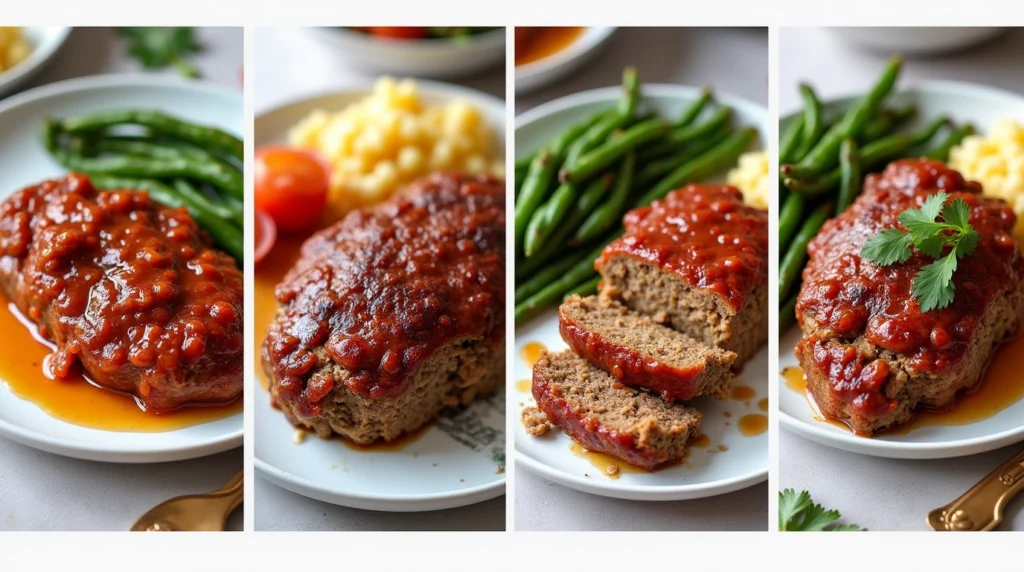
Conclusion
An easy meatloaf recipe can be much more than a quick and simple dinner—it can be a flavorful, comforting dish that brings everyone to the table. By mastering the essential ingredients, customizing the meat mixture, and perfecting the sauce, you can create a meatloaf that’s moist, tender, and bursting with flavor. Whether you stick to the classic recipe or experiment with optional add-ins and variations, meatloaf is a versatile dish that can be tailored to suit any taste.
From choosing the right meats and seasonings to adding a delicious glaze, each step is an opportunity to elevate your meal. And don’t forget, the secret to a perfect meatloaf lies in the balance of flavors—from the savory meat to the tangy, sweet sauce that tops it off.
So, next time you’re looking for an easy-to-make meal that will impress the whole family, try this simple and delicious meatloaf recipe. With a few tweaks and a little creativity, you’ll have a dish everyone will love, and it’ll soon become a family favorite. Happy cooking!

